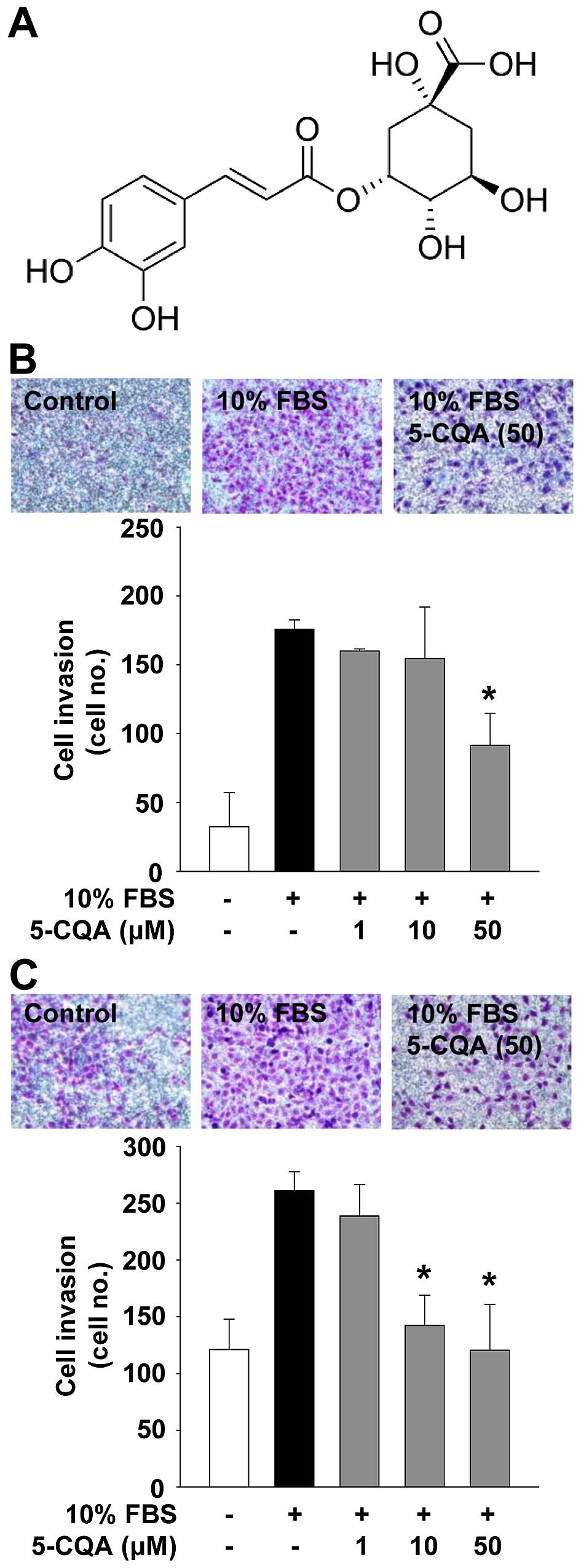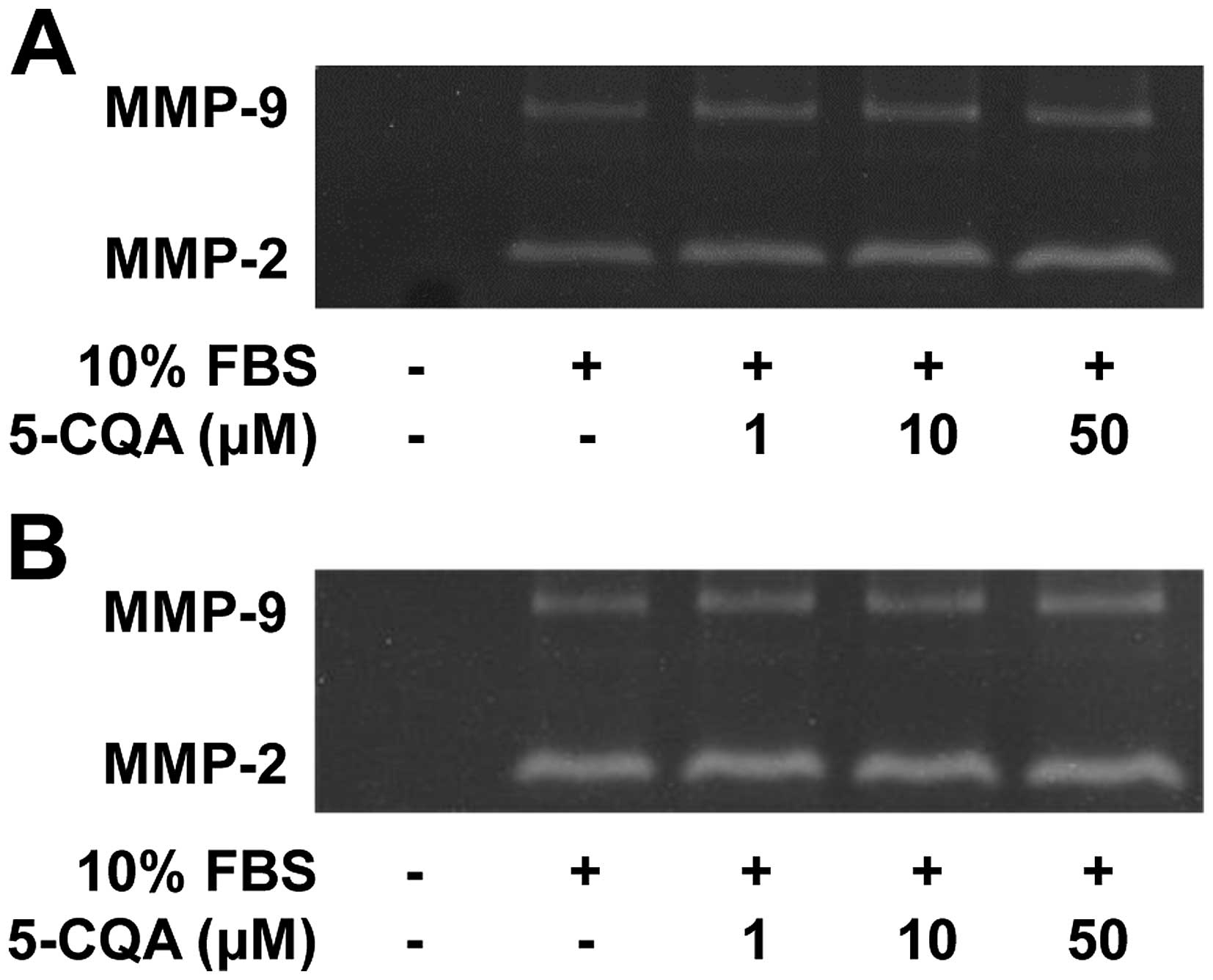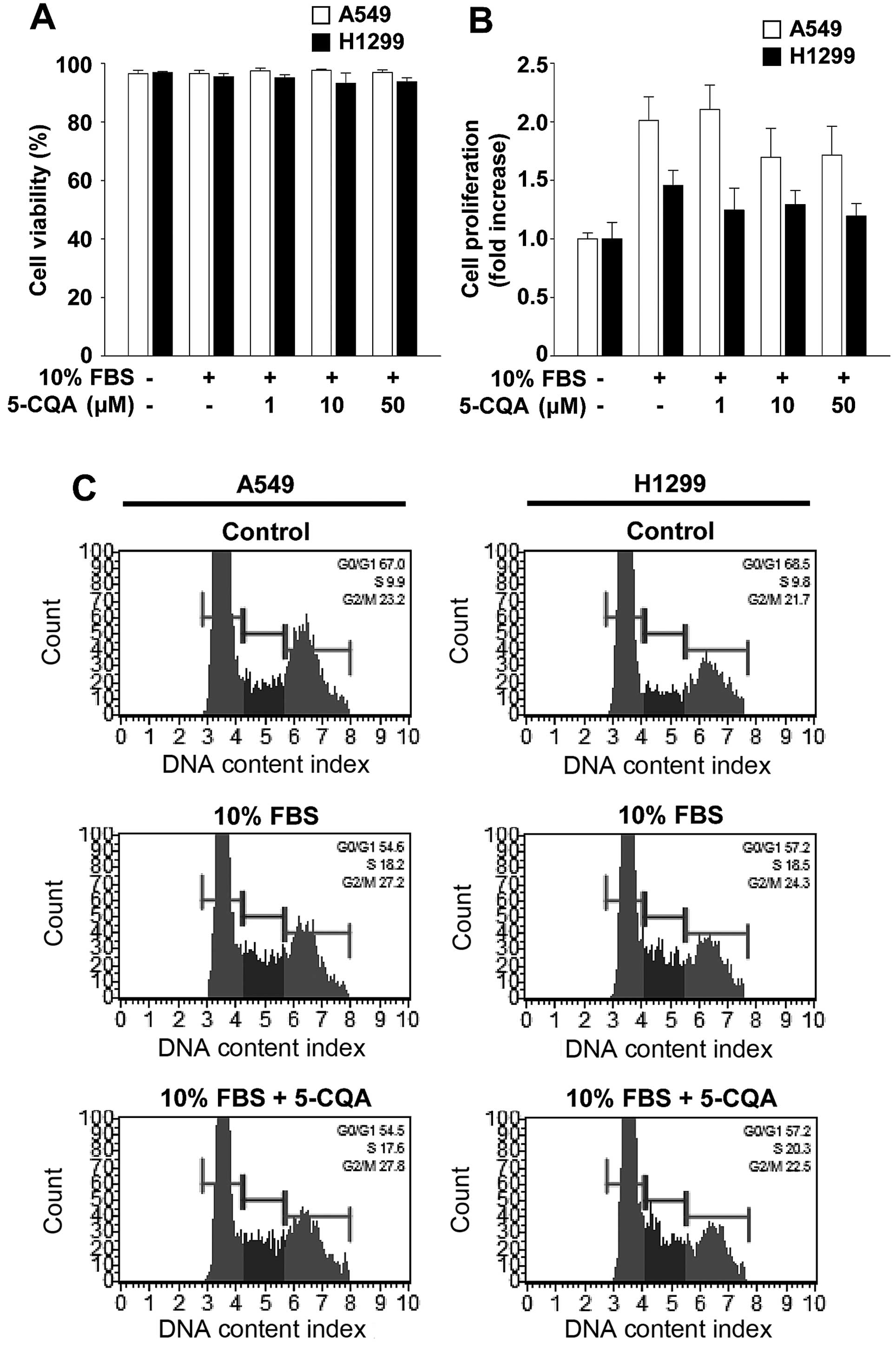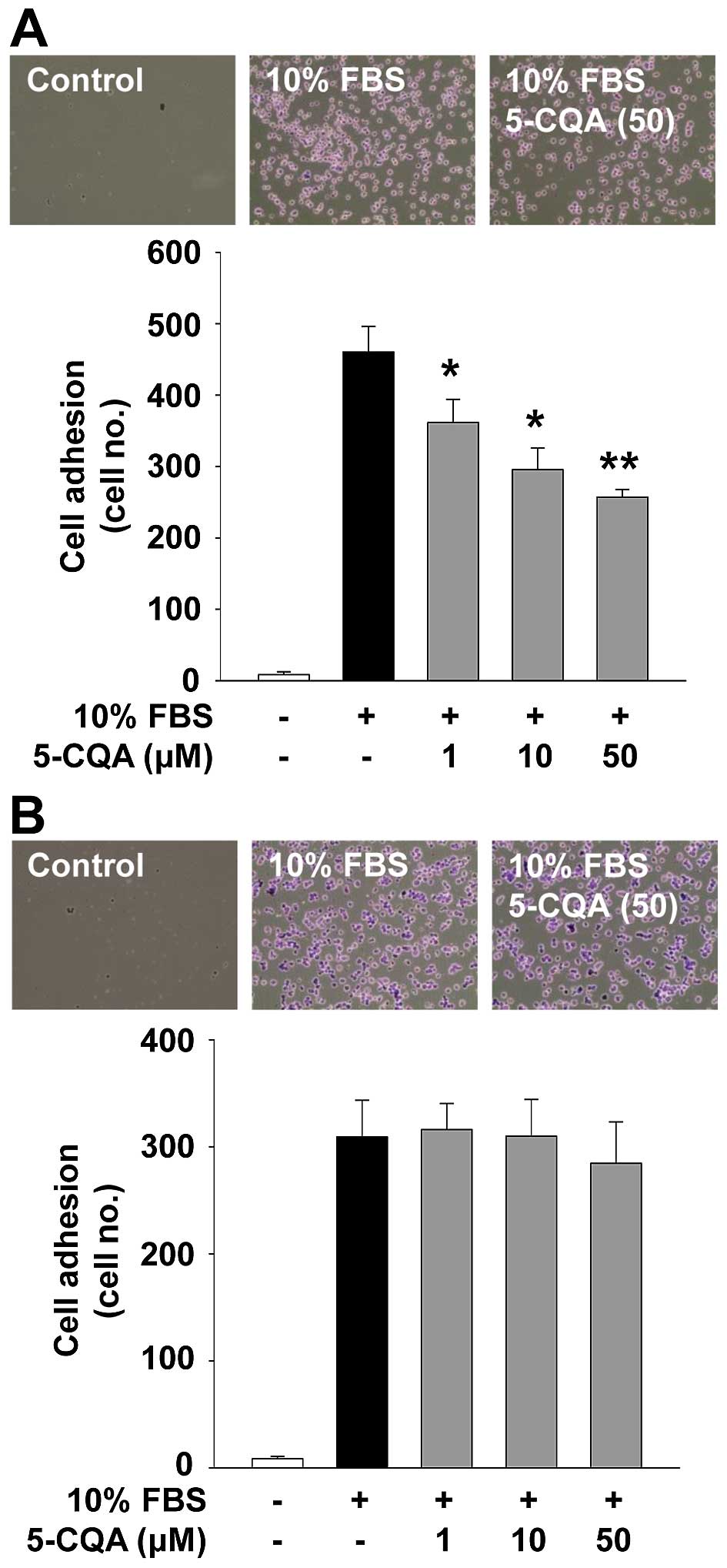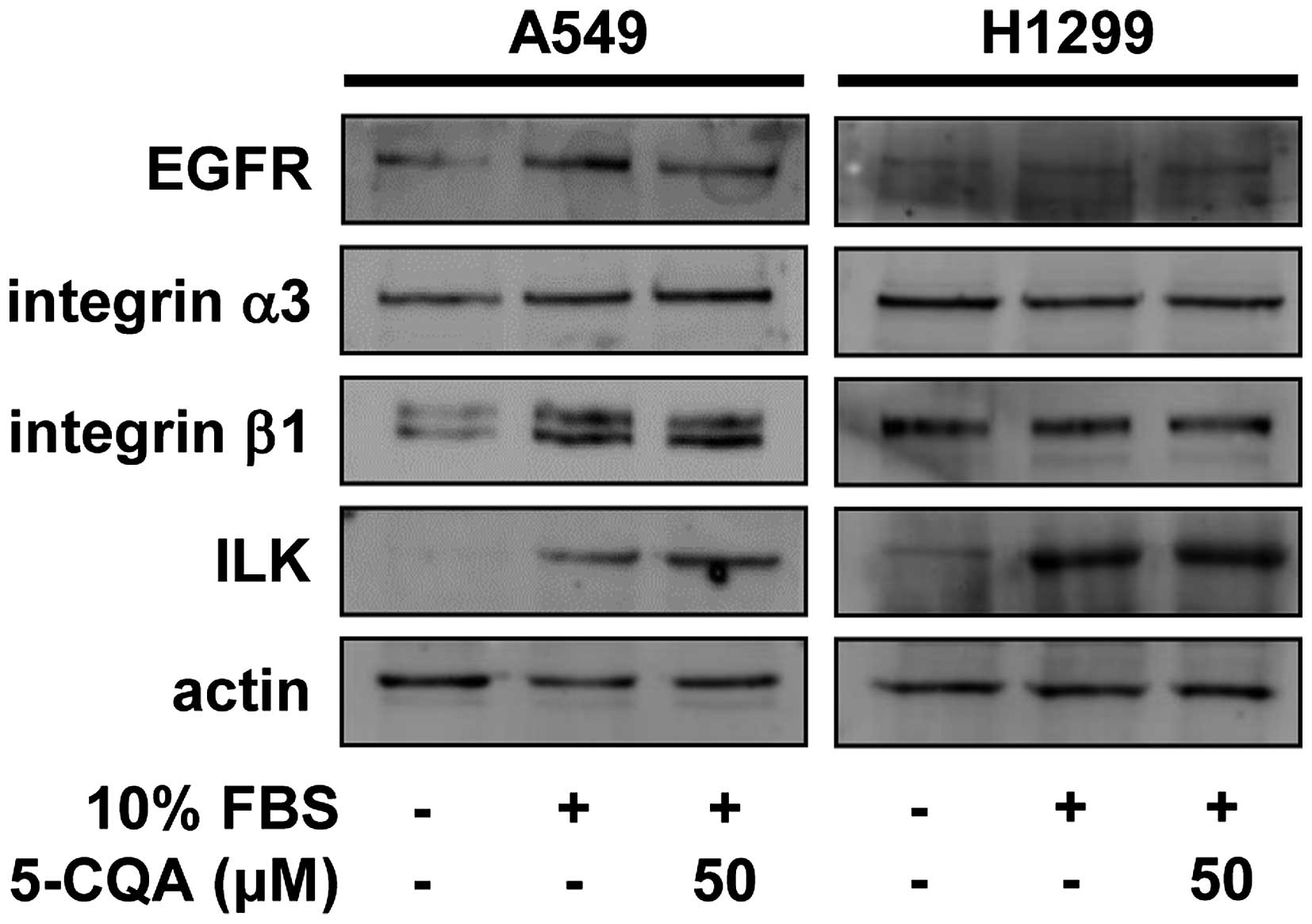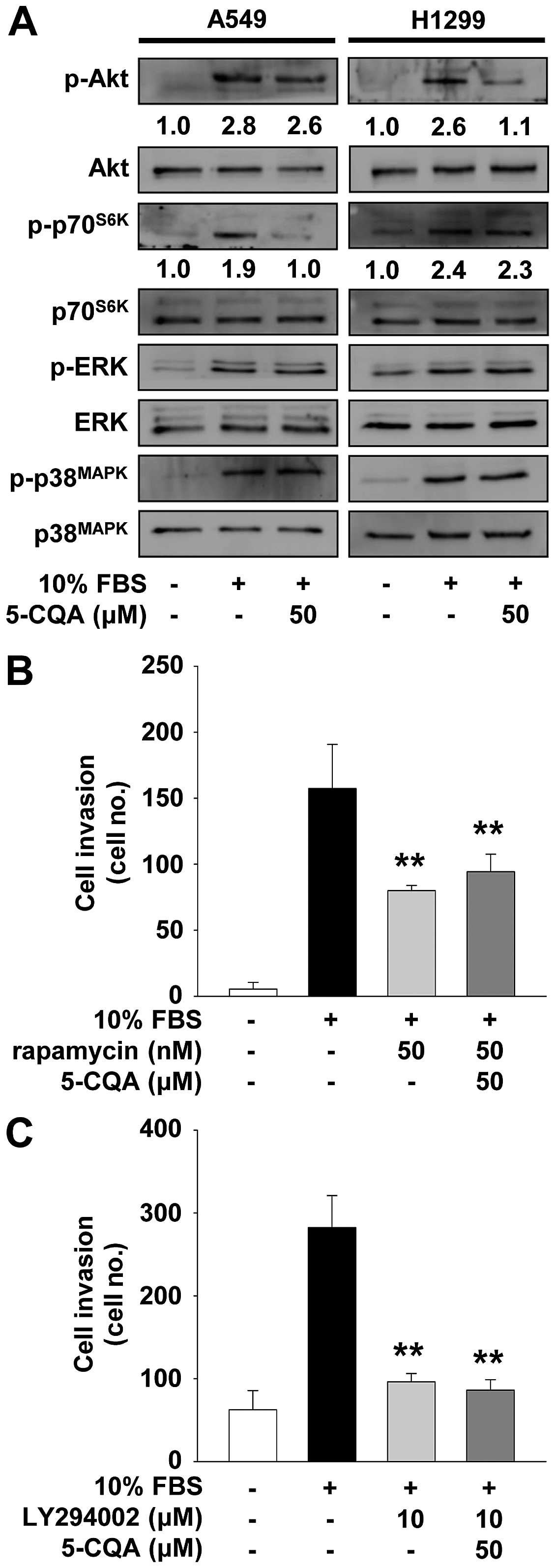5-Caffeoylquinic acid inhibits invasion of non-small cell lung cancer cells through the inactivation of p70S6K and Akt activity: Involvement of p53 in differential regulation of signaling pathways
- Authors:
- Published online on: March 10, 2016 https://doi.org/10.3892/ijo.2016.3436
- Pages: 1907-1912
Abstract
Introduction
Lung cancer is one of the most aggressive types of cancer, and the leading cause of cancer-related mortality. Approximately 85% of all diagnosed cases of lung cancer are non-small cell lung cancer (NSCLC). Extremely low survival rates in patients with lung cancer are attributable to lack of potent therapeutic targets and drugs against recurrent and metastatic phenotypes (1,2). Matrix metalloproteinases (MMPs) have been known to control cancer metastasis-related processes including cell detachment, invasion, proliferation and angiogenesis by degrading all components of extracellular matrix (ECM) and cell surface molecules. High expression and activity of MMPs are well correlated with aggressive phenotypes and poor survival of a variety of cancers (3–6). However, strategy to regulate MMP activity for the treatment of cancer has been disappointing in clinical trials (7,8). Therefore, further understanding molecular mechanisms of lung cancer growth and progression is required for the identification of therapeutic targets and development of potent anticancer agents.
Ligularia fischeri (L. fischeri) (Ledeb.) Turcz. (Compositae) has been used as a traditional medicine for the treatment of rheumatoid arthritis, scarlet fever and jaundice in eastern Asia including Korea, China and Japan. Previous investigations demonstrate that L. fischeri extract and its bioactive components such as caffeic acid and chlorogenic acid isomers possess anti-oxidant, anti-inflammatory, anti-angiogenic and anticancer properties (9–11). Chlorogenic acid isomers including 5-caffeoylquinic acid (5-CQA), which have been identified in a variety of plants including green coffee beans, walnut (Juglans regia L.) leaves, yerba-mate (Ilex paraguariensis) extract, Petasites japonicus extract and Marrubium vulgare extract as well as L. fischeri extract, have been known to exert a variety of biological functions such as anti-oxidant, anti-microbial, anti-diabetic, anti-inflammatory and anticancer activities (12–19). However, no detailed mechanisms of 5-CQA responsible for regulation of NSCLC cell fate has been clearly elucidated to date. In the present study, the regulatory effects and action mechanisms of 5-CQA on cell proliferation and differentiation were investigated in p53 wild-type A549 and p53-deficient H1299 NSCLC cells.
Materials and methods
Cell culture conditions
Human NSCLC cell lines (A549 and H1299) from the American Type Culture Collection (ATCC; Manassas, VA, USA) were grown in 10% fetal bovine serum-Dulbecco's modified Eagle's medium (FBS-DMEM; Hyclone Laboratories, Logan, UT, USA).
Reagents
5-Caffeoylquinic acid (5-CQA) was isolated from the ethanolic extract of L. fischeri. The structure of 5-CQA is presented in Fig. 1A. The following pharmacological agents and antibodies were purchased from commercial sources: mTOR/p70S6K inhibitor, rapamycin (Sigma-Aldrich, St. Louis, MO, USA); PI3K/Akt inhibitor, LY294002 (Merck Millipore, Billerica, MA, USA); anti-phospho-ERK (T202/Y204), anti-phospho-Akt (S473), anti-phospho-p70S6K (T421/S424), anti-phospho-p38MAPK (T180/Y182) and anti-p38MAPK (Cell Signaling Technology, Beverly, MA, USA); anti-integrin β1 (BD Biosciences, Bedford, MA, USA); anti-ERK, anti-Akt, anti-p70S6K, anti-EGFR, anti-integrin α3, anti-ILK, anti-actin antibodies, and mouse and rabbit IgG-horseradish peroxidase conjugates (Santa Cruz Biotechnology, Santa Cruz, CA, USA).
Cell invasion assay
The upper side of the Transwell insert (Costar, 6.5 mm diameter insert, 8 μm pore size; Corning Inc., Corning, NY, USA) was coated with 50 μl of 1 mg/ml Matrigel® (BD Biosciences) diluted in serum-free DMEM. Aliquots (100 μl) of cells (5×105 cells/ml) resuspended in serum-free DMEM were added to the upper compartment of the Matrigel-coated Transwell and 600 μl of serum-free DMEM were added to the lower compartment. After serum starvation for 2 h, cells were pretreated with 5-CQA (1–50 μM) for 30 min in the presence or absence of rapamycin (50 nM) or LY294002 (10 μM), followed by 10% FBS stimulation for 16 h. The inserts were fixed with methanol and using a cotton-tipped swab the non-invasive cells were removed from the top of the membrane. After staining with 0.04% Giemsa staining solution (Sigma-Aldrich), the numbers of invasive cells (mean ± standard deviation) were determined from six different fields using x200 objective magnification (20).
Zymogram analysis
Activities of MMPs were measured by zymography (21). Aliquots of conditioned medium were diluted in sample buffer, and applied to 10% polyacrylamide gels containing 1 mg/ml gelatin (Sigma-Aldrich) as a substrate. After electrophoresis, the gels were incubated in 2.5% Triton X-100 for 1 h to remove SDS and allow re-naturalization of MMPs, and further incubated in developing buffer containing 50 mM Tris-HCl (pH 7.5), 10 mM CaCl2, and 150 mM NaCl for 16 h at 37°C. The gels were stained with 0.5% Coomassie brilliant blue R-250 in 30% methanol-10% acetic acid for 2 h, and followed by destaining with 30% methanol-10% acetic acid. Gelatinolytic activities were detected as unstained bands against the background of the Coomassie blue-stained gelatin.
Cell viability and proliferation assay
Subconfluent A549 and H1299 cells, plated on 6-well plates (5×104 cells/well; SPL Life Sciences Co., Ltd., Gyeonggi-do, Korea), were serum-starved for 24 h in basal DMEM to synchronize cells in the G1/G0 phase of the cell cycle, and treated with 5-CQA (1–50 μM) for 30 min prior to 10% FBS stimulation for 24 h. Following culture for 24 h, cell viability was determined by a Muse™cell analyzer using cell count and viability assay kit (Merck Millipore), and the cell proliferation was quantified as previously described (22). The results from triplicate determinations (mean ± standard deviation) are presented as the percentage of viable cells of total cell count or the fold-increase of the untreated controls.
Cell cycle analysis
Quiescent cells were pretreated with 5-CQA (50 μM) for 30 min, and further incubated with 10% FBS for 24 h. Cells were harvested with trypsin-EDTA, rinsed with phosphate-buffered saline (PBS, pH 7.4) and then fixed with ice-cold 70% ethanol for 3 h. After washing with PBS, cells were stained with Muse™ cell cycle reagent (Merck Millipore). The profile of cells in the G1/G0, S and G2/M phases of the cell cycle was analyzed with a Muse cell analyzer (23).
Western blot analysis
Quiescent cells were pretreated with 5-CQA for 30 min, followed by 10% FBS stimulation for 15 min or 24 h. Cells were rinsed twice with ice-cold PBS and lysed by incubation in 50 mM Tris-HCl (pH 7.4), 150 mM NaCl, 10% glycerol, 1% Triton X-100, 1 mM EDTA, 100 μg/ml AEBSF, 10 μg/ml aprotinin, 1 μg/ml pepstatin A, 0.5 μg/ml leupeptin, 80 mM β-glycerophosphate, 25 mM sodium fluoride and 1 mM sodium orthovanadate for 30 min at 4°C. Cell lysates were clarified at 13,000 x g for 20 min at 4°C, and the supernatants were subjected to western blot analysis as previously described (24). All western blots are representative of at least three independent experiments. Bands of interest were integrated and quantified by the use of National Institutes of Health (NIH) ImageJ version 1.34s software.
Cell adhesion assay
Subconfluent cells were detached with trypsin-EDTA and allowed to recover in 10% FBS-DMEM for 1 h at 37°C with gentle rocking. After recovery, the cells were collected by low-speed centrifugation and resuspended in serum-free DMEM. The cell suspension was pretreated with 5-CQA for 30 min, and followed by 10% FBS stimulation. The cells were plated on 96-well plates (1.5×104 cells/well), and further incubated for 1 h at 37°C. Following incubation unattached cells were removed by washing the wells three times with PBS. Attached cells were fixed with methanol, and then stained with 0.04% Giemsa staining solution. The cells were photographed and counted. The results (mean ± standard deviation) are presented as the number of adherent cells (25,26).
Statistical analysis
Statistical analysis was performed using the Student's t-test, and was based on at least three different experiments. The results were considered to be statistically significant at P<0.05.
Results
5-CQA inhibits NSCLC cell invasion
We first analyzed the effect of 5-CQA on cell invasion which plays pivotal roles in cancer progression. 5-CQA treatment dose-dependently blocked mitogen-stimulated cell invasion in p53 wild-type A549 and p53-deficient H1299 NSCLC cells (Fig. 1B and C). H1299 cells appeared to be more responsive to 5-CQA-mediated inhibition of cell invasion, as compared with A549 cells, indicating that anti-invasive activity of 5-CQA might be dependent on p53 expression status. We next examined the activity of matrix metalloproteinases (MMPs) in 5-CQA-treated NSCLC cells. As shown in Fig. 2, the conditioned media from cell cultures had high levels of MMP-2 activity relative to those of MMP-9. 5-CQA treatment did not alter activity of MMP-2 and MMP-9 in response to mitogenic stimulation. In addition, the levels of MMP-2, MMP-9 or tissue inhibitor of metalloproteinase-2, an endogenous inhibitor of MMP, were not changed in 5-CQA-treated cells (data not shown), suggesting the inhibitory effect of 5-CQA on cell invasion might be mediated through an MMP-independent mechanism. However, the possibility that 5-CQA may regulate the expression and activity of other MMPs and their endogenous inhibitors cannot be excluded (3,27–29).
5-CQA does not alter viability and proliferation in NSCLC cells
Based on 5-CQA-mediated inhibition of cell invasion, we investigated the possibility that cytotoxicity or anti-proliferative effect of 5-CQA might mediate anti-invasive activity. 5-CQA treatment did not significantly alter cell viability and proliferation in A549 or H1299 cells (Fig. 3A and B). To ascertain that 5-CQA had little or no effect on cell proliferation, we next examined the ability of 5-CQA to regulate cell cycle progression (Fig. 3C). Mitogenic stimulation for 24 h increased the percentage of cells in S and G2/M phases, and simultaneously decreased the percentage of cells in G1 phase, compared with untreated controls. 5-CQA treatment did not alter the percentage of G1, S and G2/M phases of the cell cycle associated with mitogenic stimulation. Moreover, our initial experiments indicate that 5-CQA treatment did not change the percentage of live, apoptotic or dead cells in either cell line at the highest concentration used in this study (data not shown). Collectively, these findings demonstrate that 5-CQA directly regulates cell invasion without any effect on cell cycle progression, cell proliferation or cell viability in NSCLC cells.
5-CQA inhibits adhesion in A549 cells
Cell adhesion and migration associated with cancer cell growth and progression are controlled by interactions with ECM molecules and cellular components (4). We next investigated the ability of 5-CQA to regulate cell adhesion. As shown in Fig. 4, 5-CQA treatment dose-dependently suppressed mitogen-stimulated cell adhesion in A549 cells, but not in H1299 cells. Although the inhibitory effect and functional consequences of 5-CQA on cell adhesion in A549 cells remain to be addressed, 5-CQA-mediated inhibition of cell adhesion did not appear to affect the cell viability and proliferation (Fig. 3A and B), and may contribute to the modulation of cell invasion (Fig. 1B and C).
Differential regulation of 5-CQA in mitogen-stimulated signaling pathways in NSCLC cells
To investigate the molecular mechanisms and therapeutic targets of 5-CQA in regulating cell invasion, we first examined the changes in the expression of cell surface signaling-related molecules such as epidermal growth factor receptor (EGFR), integrin α3β1 and integrin-linked kinase (ILK) in 5-CQA-treated NSCLC cells (30,31). 5-CQA treatment did not significantly change the expression of EGFR, integrin α3β1 and ILK in either cell line (Fig. 5), raising the possibility that 5-CQA-mediated inhibition of cell invasion might be mediated through the regulation of downstream signaling pathways of receptor tyrosine kinases (RTKs) and integrins. Therefore, we next analyzed the changes in activation of mitogen-stimulated signaling pathways including phosphatidylinositol 3-kinase (PI3K)/Akt, mammalian target of rapamycin (mTOR)/p70S6K, extracellular signal-regulated kinase (ERK) and p38 mitogen-activated protein kinase (p38MAPK) in 5-CQA-treated cells (10,20,32). As shown in Fig. 6A, mitogenic stimulation increased the phosphorylation/activation of Akt, p70S6K, ERK and p38MAPK, as compared with unstimulated controls. 5-CQA treatment markedly inhibited mitogen-stimulated activation/phosphorylation of p70S6K, but not Akt, ERK and p38MAPK, in A549 cells. Pretreatment of A549 cells with rapamycin, an inhibitor of mTOR/p70S6K pathway, mimicked the suppressive effect of 5-CQA on cell invasion (Fig. 6B). In contrast, 5-CQA treatment inhibited mitogen-stimulated phosphorylation of Akt in H1299 cells (Fig. 6A). Inhibition of PI3K/Akt signaling pathway by LY294002 suppressed cell invasion similarly in 5-CQA-treated H1299 cells (Fig. 6C). Co-treatment with 5-CQA did not enhance the inhibitory effect of these chemical inhibitors on cell invasion, suggesting that 5-CQA and these inhibitors may share similar roles and mechanisms of action in regulating NSCLC cell invasion.
Discussion
L. fischeri has been consumed as an edible herb and traditional medicine for the treatment of inflammatory and infectious diseases. 5-Caffeoylquinic acid (5-CQA), a chlorogenic acid isomer isolated from a variety of plants including L. fischeri, has been reported to possess anti-oxidant, anti-bacterial and anti-inflammatory activities (13–16,19). In addition, some previous studies demonstrate that 5-CQA exerts anticancer activity against several types of cancer cells including breast and colon cancer (12,18,33). However, the effects and molecular mechanism of 5-CQA on lung cancer cell growth and progression have not yet been reported.
Overexpression or dysregulated activation of EGFR is known to be closely correlated with malignancy and poor prognosis in human lung cancer, suggesting the potential role of EGFR and its downstream signaling pathways as therapeutic targets for the treatment of lung cancer (30). In addition, recent studies demonstrate that cross-talk between RTKs including EGFR and cell adhesion receptors such as integrins plays pivotal roles in cancer growth and progression (31). Therefore, identification of key molecular targets and their roles in RTK/integrin signaling pathways is required for the development of potential therapeutic strategies and agents to treat cancer.
In the present study, we demonstrate that 5-CQA exhibits strong anti-invasive activity against both p53-positive and p53-negative NSCLC cells without any influence on cell proliferation, apoptosis or cytotoxicity. In addition, 5-CQA does not alter the expression of EGFR and integrin α3β1, but differentially modulates mitogen-stimulated signaling pathways, depending on the status of p53 expression in NSCLC cells. Inactivation of p70S6K and Akt by 5-CQA contributes to inhibition of cell invasion in p53 wild-type A549 and p53-deficient H1299 cells, respectively, suggesting the possibility of p53 involvement in 5-CQA-mediated differential regulation of mitogen-stimulated signaling components. In conclusion, this is the first report that 5-CQA exerts anti-invasive activity against NSCLC cells through p53-dependent regulation of signaling pathways, and warrants further evaluation and development of 5-CQA as a potent anticancer agent for the treatment of NSCLC.
Acknowledgements
The present study was supported by the Research Fund of Dankook University in 2015.
References
|
Torre LA, Bray F, Siegel RL, Ferlay J, Lortet-Tieulent J and Jemal A: Global cancer statistics, 2012. CA Cancer J Clin. 65:87–108. 2015. View Article : Google Scholar : PubMed/NCBI | |
|
Chen Z, Fillmore CM, Hammerman PS, Kim CF and Wong KK: Non-small-cell lung cancers: A heterogeneous set of diseases. Nat Rev Cancer. 14:535–546. 2014. View Article : Google Scholar : PubMed/NCBI | |
|
Kessenbrock K, Plaks V and Werb Z: Matrix metalloproteinases: Regulators of the tumor microenvironment. Cell. 141:52–67. 2010. View Article : Google Scholar : PubMed/NCBI | |
|
Bourboulia D and Stetler-Stevenson WG: Matrix metalloproteinases (MMPs) and tissue inhibitors of metalloproteinases (TIMPs): Positive and negative regulators in tumor cell adhesion. Semin Cancer Biol. 20:161–168. 2010. View Article : Google Scholar : PubMed/NCBI | |
|
Kim SH, Cho YR, Kim HJ, Oh JS, Ahn EK, Ko HJ, Hwang BJ, Lee SJ, Cho Y, Kim YK, et al: Antagonism of VEGF-A-induced increase in vascular permeability by an integrin α3β1-Shp-1-cAMP/PKA pathway. Blood. 120:4892–4902. 2012. View Article : Google Scholar : PubMed/NCBI | |
|
Hadler-Olsen E, Winberg JO and Uhlin-Hansen L: Matrix metalloproteinases in cancer: Their value as diagnostic and prognostic markers and therapeutic targets. Tumour Biol. 34:2041–2051. 2013. View Article : Google Scholar : PubMed/NCBI | |
|
Overall CM and Kleifeld O: Tumour microenvironment - opinion: Validating matrix metalloproteinases as drug targets and anti-targets for cancer therapy. Nat Rev Cancer. 6:227–239. 2006. View Article : Google Scholar : PubMed/NCBI | |
|
Vandenbroucke RE and Libert C: Is there new hope for therapeutic matrix metalloproteinase inhibition? Nat Rev Drug Discov. 13:904–927. 2014. View Article : Google Scholar : PubMed/NCBI | |
|
Kim JH, Kim HJ, Kim JK, Ahn EK, Ko HJ, Cho YR, Lee SJ, Bae GU, Kim YK, Park JW, et al: Ligularia fischeri inhibits endothelial cell proliferation, invasion and tube formation through the inactivation of mitogenic signaling pathways and regulation of vascular endothelial cadherin distribution and matrix metalloproteinase expression. Oncol Rep. 34:221–226. 2015.PubMed/NCBI | |
|
Cho YR, Kim JK, Kim JH, Oh JS and Seo DW: Ligularia fischeri regulates lung cancer cell proliferation and migration through down-regulation of epidermal growth factor receptor and integrin β1 expression. Genes Genomics. 35:741–746. 2013. View Article : Google Scholar | |
|
Lee HN, Kim JK, Kim JH, Lee SJ, Ahn EK, Oh JS and Seo DW: A mechanistic study on the anti-cancer activity of ethyl caffeate in human ovarian cancer SKOV-3 cells. Chem Biol Interact. 219:151–158. 2014. View Article : Google Scholar : PubMed/NCBI | |
|
Iwai K, Kishimoto N, Kakino Y, Mochida K and Fujita T: In vitro antioxidative effects and tyrosinase inhibitory activities of seven hydroxycinnamoyl derivatives in green coffee beans. J Agric Food Chem. 52:4893–4898. 2004. View Article : Google Scholar : PubMed/NCBI | |
|
Pereira JA, Oliveira I, Sousa A, Valentão P, Andrade PB, Ferreira ICFR, Ferreres F, Bento A, Seabra R and Estevinho L: Walnut (Juglans regia L.) leaves: Phenolic compounds, antibacterial activity and antioxidant potential of different cultivars. Food Chem Toxicol. 45:2287–2295. 2007. View Article : Google Scholar : PubMed/NCBI | |
|
Zhao Z, Shin HS, Satsu H, Totsuka M and Shimizu M: 5-caffeoylquinic acid and caffeic acid down-regulate the oxidative stress- and TNF-α-induced secretion of interleukin-8 from Caco-2 cells. J Agric Food Chem. 56:3863–3868. 2008. View Article : Google Scholar : PubMed/NCBI | |
|
Berté KA, Beux MR, Spada PK, Salvador M and Hoffmann-Ribani R: Chemical composition and antioxidant activity of yerba-mate (Ilex paraguariensis A.St.-Hil, Aquifoliaceae) extract as obtained by spray drying. J Agric Food Chem. 59:5523–5527. 2011. View Article : Google Scholar | |
|
Kim SM, Kang SW, Jeon J-S, Jung YJ, Kim CY, Pan CH and Um BH: Rapid identification and evaluation of antioxidant compounds from extracts of Petasites japonicus by hyphenated-HPLC techniques. Biomed Chromatogr. 26:199–207. 2012. View Article : Google Scholar | |
|
Boudjelal A, Henchiri C, Siracusa L, Sari M and Ruberto G: Compositional analysis and in vivo anti-diabetic activity of wild Algerian Marrubium vulgare L. infusion. Fitoterapia. 83:286–292. 2012. View Article : Google Scholar | |
|
Murad LD, Soares NC, Brand C, Monteiro MC and Teodoro AJ: Effects of caffeic and 5-caffeoylquinic acids on cell viability and cellular uptake in human colon adenocarcinoma cells. Nutr Cancer. 67:532–542. 2015. View Article : Google Scholar : PubMed/NCBI | |
|
Liu SL, Peng BJ, Zhong YL, Liu YL, Song Z and Wang Z: Effect of 5-caffeoylquinic acid on the NF-κB signaling pathway, peroxisome proliferator-activated receptor gamma 2, and macrophage infiltration in high-fat diet-fed Sprague-Dawley rat adipose tissue. Food Funct. 6:2779–2786. 2015. View Article : Google Scholar : PubMed/NCBI | |
|
Lee HN, Joo JH, Oh JS, Choi SW and Seo DW: Regulatory effects of Siegesbeckia glabrescens on non-small cell lung cancer cell proliferation and invasion. Am J Chin Med. 42:453–463. 2014. View Article : Google Scholar : PubMed/NCBI | |
|
Cho YR, Kim JH, Kim JK, Ahn EK, Ko HJ, In JK, Lee SJ, Bae GU, Kim YK, Oh JS, et al: Broussonetia kazinoki modulates the expression of VEGFR-2 and MMP-2 through the inhibition of ERK, Akt and p70S6K-dependent signaling pathways: Its implication in endothelial cell proliferation, migration and tubular formation. Oncol Rep. 32:1531–1536. 2014.PubMed/NCBI | |
|
Kim JH, Kim JK, Ahn EK, Ko HJ, Cho YR, Lee CH, Kim YK, Bae GU, Oh JS and Seo DW: Marmesin is a novel angiogenesis inhibitor: Regulatory effect and molecular mechanism on endothelial cell fate and angiogenesis. Cancer Lett. 369:323–330. 2015. View Article : Google Scholar : PubMed/NCBI | |
|
Joo JH, Hong SS, Cho YR and Seo DW: 10-Gingerol inhibits proliferation and invasion of MDA-MB-231 breast cancer cells through suppression of Akt and p38MAPK activity. Oncol Rep. 35:779–784. 2016. | |
|
Kim HJ, Cho YR, Kim SH and Seo DW: TIMP-2-derived 18-mer peptide inhibits endothelial cell proliferation and migration through cAMP/PKA-dependent mechanism. Cancer Lett. 343:210–216. 2014. View Article : Google Scholar | |
|
Yoon HJ, Cho YR, Joo JH and Seo DW: Knockdown of integrin α3β1 expression induces proliferation and migration of non-small cell lung cancer cells. Oncol Rep. 29:662–668. 2013. | |
|
Kim HJ, Ko HY, Choi SW and Seo DW: Anti-angiogenic effects of Siegesbeckia glabrescens are mediated by suppression of the Akt and p70S6K-dependent signaling pathways. Oncol Rep. 33:699–704. 2015. | |
|
Brew K and Nagase H: The tissue inhibitors of metalloproteinases (TIMPs): An ancient family with structural and functional diversity. Biochim Biophys Acta. 1803:55–71. 2010. View Article : Google Scholar : PubMed/NCBI | |
|
Seo DW, Li H, Guedez L, Wingfield PT, Diaz T, Salloum R, Wei BY and Stetler-Stevenson WG: TIMP-2 mediated inhibition of angiogenesis: An MMP-independent mechanism. Cell. 114:171–180. 2003. View Article : Google Scholar : PubMed/NCBI | |
|
Stetler-Stevenson WG: Tissue inhibitors of metalloproteinases in cell signaling: metalloproteinase-independent biological activities. Sci Signal. 1:re62008. View Article : Google Scholar : PubMed/NCBI | |
|
Sharma SV, Bell DW, Settleman J and Haber DA: Epidermal growth factor receptor mutations in lung cancer. Nat Rev Cancer. 7:169–181. 2007. View Article : Google Scholar : PubMed/NCBI | |
|
Desgrosellier JS and Cheresh DA: Integrins in cancer: Biological implications and therapeutic opportunities. Nat Rev Cancer. 10:9–22. 2010. View Article : Google Scholar | |
|
Lemmon MA and Schlessinger J: Cell signaling by receptor tyrosine kinases. Cell. 141:1117–1134. 2010. View Article : Google Scholar : PubMed/NCBI | |
|
Taira J, Uehara M, Tsuchida E and Ohmine W: Inhibition of the β-catenin/Tcf signaling by caffeoylquinic acids in sweet potato leaf through down regulation of the Tcf-4 transcription. J Agric Food Chem. 62:167–172. 2014. View Article : Google Scholar |



